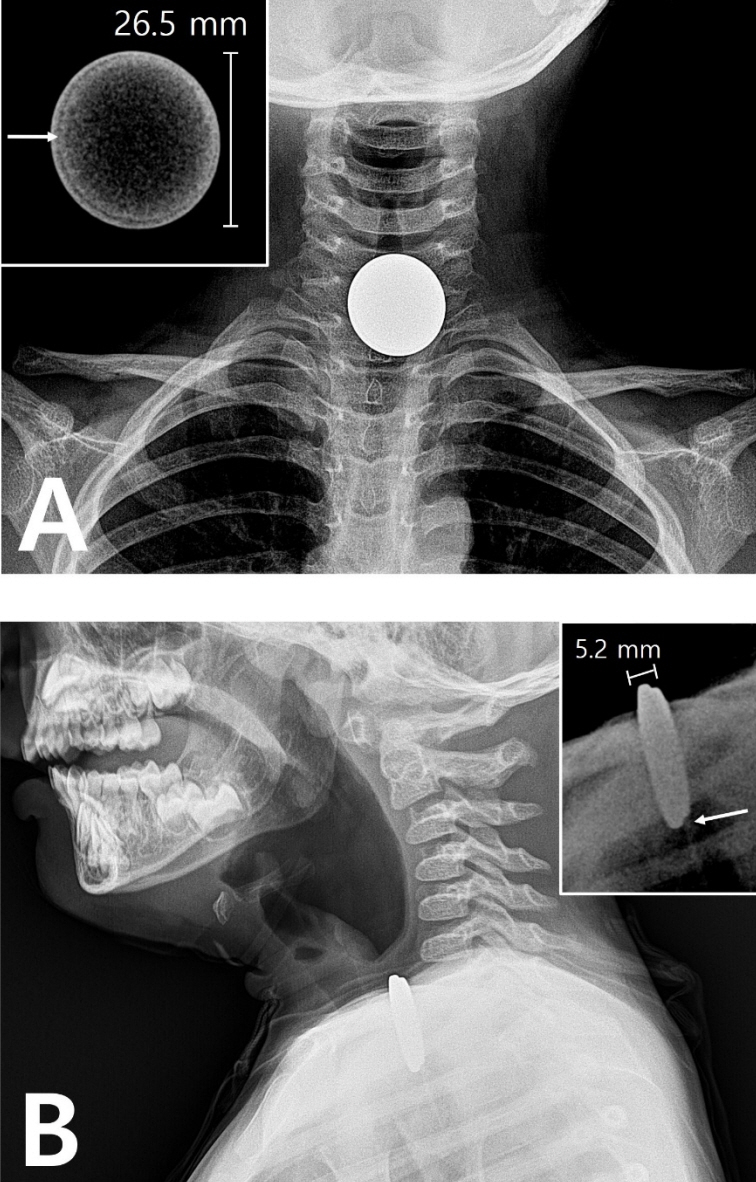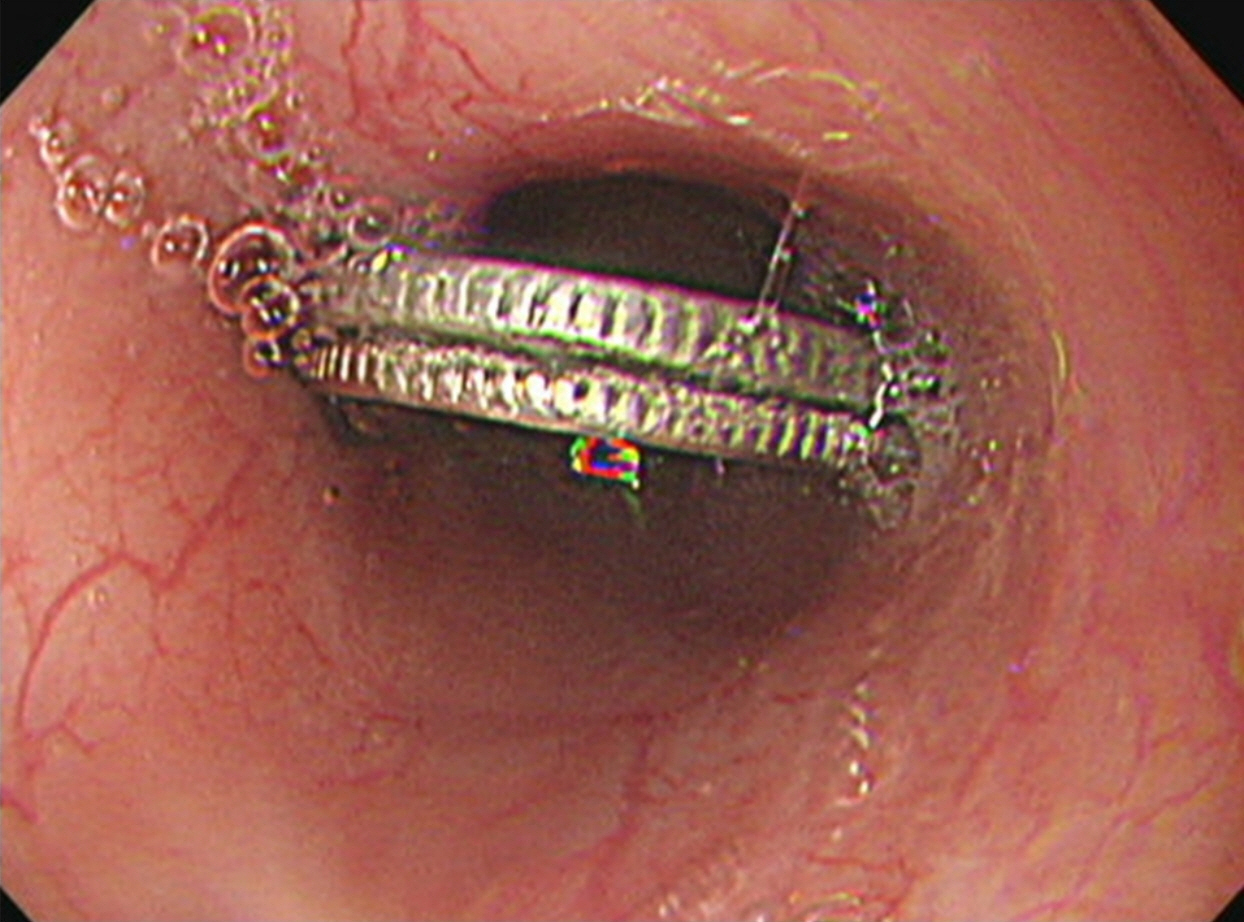Pediatr Emerg Med J.
2021 Dec;8(2):116-119. 10.22470/pemj.2021.00283.
A case of stacked coin ingestion mistaken for button battery
- Affiliations
-
- 1Department of Pediatrics, Asan Medical Center, University of Ulsan College of Medicine, Seoul, Korea
- KMID: 2524006
- DOI: http://doi.org/10.22470/pemj.2021.00283
Abstract
- Button battery ingestion requires emergency endoscopic removal since severe complications, such as esophageal perforation, can develop within 4 hours of the ingestion. Given that guardians do not witness the children’s foreign body ingestion 40% of the time, physicians can only guess what was swallowed based on plain radiography. We report a case of a 45-month-old-boy who visited the emergency department after swallowing an unknown foreign body and whose radiographs showed “circle-within-a-circle appearance” on the anteroposterior view and “step-off appearance” on the lateral view, suggesting button battery ingestion. We conducted emergency endoscopic removal, and found stacked coins mimicking a button battery on the radiographs. The coins were pushed into the stomach and came out through defecation 3 weeks later without further complications. Distinguishing between stacked coins and a button battery through radiography may help avoid unnecessary emergency endoscopy.
Keyword
Figure
Reference
-
References
1. Korea Consumer Agency. Trend analysis of pediatric accident in Korea, 2019 [Internet]. Eumseong-gun (Korea): Korea Consumer Agency;2020. [cited 2021 May 10]. Available from: http://www.isafe.go.kr/children/downloadBbsFile.do?atchmnflNo=13608. Korean.2. Varga A, Kovacs T, Saxena AK. Analysis of complications after button battery ingestion in children. Pediatr Emerg Care. 2018; 34:443–6.
Article3. Volker J, Volker C, Schendzielorz P, Schraven SP, Radeloff A, Mlynski R, et al. Pathophysiology of esophageal impairment due to button battery ingestion. Int J Pediatr Otorhinolaryngol. 2017; 100:77–85.4. Litovitz T, Whitaker N, Clark L. Preventing battery ingestions: an analysis of 8648 cases. Pediatrics. 2010; 125:1178–83.
Article5. Krom H, Visser M, Hulst JM, Wolters VM, Van den Neucker AM, de Meij T, et al. Serious complications after button battery ingestion in children. Eur J Pediatr. 2018; 177:1063–70.
Article6. Waltzman ML, Baskin M, Wypij D, Mooney D, Jones D, Fleisher G. A randomized clinical trial of the management of esophageal coins in children. Pediatrics. 2005; 116:614–9.
Article7. Valdez AM. Button battery injuries: primary and secondary prevention strategies. J Emerg Nurs. 2014; 40:625–6.
Article8. Lee SC, Ebert CS Jr, Fordham L, Rose AS. Plain films in the evaluation of batteries as esophageal foreign bodies. Int J Pediatr Otorhinolaryngol. 2008; 72:1487–91.
Article9. Whelan R, Shaffer A, Dohar JE. Button battery versus stacked coin ingestion: a conundrum for radiographic diagnosis. Int J Pediatr Otorhinolaryngol. 2019; 126:109627.
Article10. Silverberg M, Tillotson R. Case report: esophageal foreign body mistaken for impacted button battery. Pediatr Emerg Care. 2006; 22:262–5.11. Frumkin K, Lanker M. Suspected esophageal coin: look again. Am J Emerg Med. 2016; 34:680 e3–4.
- Full Text Links
- Actions
-
Cited
- CITED
-
- Close
- Share
- Similar articles
-
- Two Cases of Button Battery in Nasal Cavity
- Two Cases of Colonoscopic Retrieval of a Foreign Body in Children: A Button Battery and an Open Safety Pin
- Impaction of Coin Battery in the Appendix
- Nasal Septal Perforation due to Button Battery
- Foreign Body Ingestion in Children: Should Button Batteries in the Stomach Be Urgently Removed?



